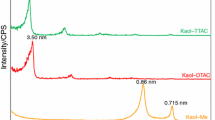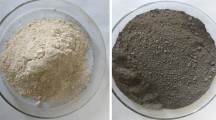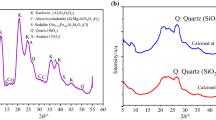Abstract
The thermal decomposition process of kaolinite–potassium acetate intercalation complex has been studied using simultaneous thermogravimetry coupled with Fourier-transform infrared spectroscopy and mass spectrometry (TG-FTIR-MS). The results showed that the thermal decomposition of the complex took place in four temperature ranges, namely 50–100, 260–320, 320–550, and 650–780 °C. The maximal mass losses rate for the thermal decomposition of the kaolinite–potassium acetate intercalation complex was observed at 81, 296, 378, 411, 486, and 733 °C, which was attributed to (a) loss of the adsorbed water, (b) thermal decomposition of surface-adsorbed potassium acetate (KAc), (c) the loss of the water coordinated to potassium acetate in the intercalated kaolinite, (d) the thermal decomposition of intercalated KAc in the interlayer of kaolinite and the removal of inner surface hydroxyls, (e) the loss of the inner hydroxyls, and (f) the thermal decomposition of carbonate derived from the decomposition of KAc. The thermal decomposition of intercalated potassium acetate started in the range 320–550 °C accompanied by the release of water, acetone, carbon dioxide, and acetic acid. The identification of pyrolysis fragment ions provided insight into the thermal decomposition mechanism. The results showed that the main decomposition fragment ions of the kaolinite–KAc intercalation complex were water, acetone, carbon dioxide, and acetic acid. TG-FTIR-MS was demonstrated to be a powerful tool for the investigation of kaolinite intercalation complexes. It delivers a detailed insight into the thermal decomposition processes of the kaolinite intercalation complexes characterized by mass loss and the evolved gases.





Similar content being viewed by others
References
Caglar B, Çırak Ç, Tabak A, Afsin B, Eren E. Covalent grafting of pyridine-2-methanol into kaolinite layers. J Mol Struct. 2013;1032:12–22.
Matusik J, Scholtzova E, Tunega D. Influence of synthesis condition on the formation of a kaolintie-methanol complex and simulation its vibrational spectra. Clay Clay Miner. 2012;60:227–39.
Caglar B. Structural characterization of kaolinite–nicotinamide intercalation composite. J Mol Struct. 2012;1020:48–55.
Letaief S, Leclercq J, Liu Y, Detellier C. Single kaolinite nanometer layers prepared by an in situ polymerization–exfoliation process in the presence of ionic liquids. Langmuir. 2011;27:15248–54.
Cheng H, Liu Q, Zhang J, Yang J, Frost RL. Delamination of kaolinite–potassium acetate intercalates by ball-milling. J Colloid Interface Sci. 2010;348:355–9.
Cheng H, Liu Q, Yang J, Zhang Q, Frost RL. Thermal behavior and decomposition of kaolinite–potassium acetate intercalation composite. Thermochim Acta. 2010;503–504:16–20.
Letaief S, Detellier C. Functionalization of the interlayer surfaces of kaolinite by alkylammonium groups from ionic liquids. Clay Clay Miner. 2009;57:638–48.
Letaief S, Detellier C. Clay-polymer nanocomposite material from the delamination of kaolinite in the presence of sodium polyacrylate. Langmuir. 2009;25:10975–9.
Pavlidou S, Papaspyrides CD. A review on polymer-layered silicate nanocomposites. Prog Polym Sci. 2008;33:1119–98.
Frost RL, Horváth E, Makó É, Kristóf J, Cseh T. The effect of mechanochemical activation upon the intercalation of a high-defect kaolinite with formamide. J Colloid Interface Sci. 2003;265:386–95.
Frost RL, Horváth E, Makó É, Kristóf J. Modification of low- and high-defect kaolinite surfaces: implications for kaolinite mineral processing. J Colloid Interface Sci. 2004;270:337–46.
Gardolinski JEFC, Lagaly G. Grafted organic derivatives of kaolinite: II. Intercalation of primary n-alkylamines and delamination. Clay Miner. 2005;40:547–56.
Jia X, Li Y, Zhang B, Cheng Q, Zhang S. Preparation of poly(vinyl alcohol)/kaolinite nanocomposites via in situ polymerization. Mater Res Bull. 2008;43:611–7.
Franco F, Pérez-Maqueda LA, Pérez-Rodr´ıguez JL. The influence of ultrasound on the thermal behaviour of a well ordered kaolinite. Thermochim Acta. 2003;404:71–9.
Franco F, Pérez-Maqueda LA, Pérez-Rodríguez JL. The effect of ultrasound on the particle size and structural disorder of a well-ordered kaolinite. J Colloid Interface Sci. 2004;274:107–17.
Franco F, Cecila JA, Pérez-Maqueda LA, Pérez-Rodríguez JL, Gomes CSF. Particle-size reduction of dickite by ultrasound treatments: effect on the structure, shape and particle-size distribution. Appl Clay Sci. 2007;35:119–27.
Churchman GJ, Whitton JS, Claridge GGC, Theng BKG. Intercalation method using formamide for differentiating halloysite from kaolinite. Clays Clay Miner. 1984;32:241–8.
Joussein E, Petit S, Delvaux B. Behavior of halloysite clay under formamide treatment. Appl Clay Sci. 2007;35:17–24.
Costanzo PM, Giese RF. Ordered halloysite: dimethylsulfoxide intercalate. Clays Clay Miner. 1986;34:105–7.
Nicolini KP, Fukamachi CRB, Wypych F, Mangrich AS. Dehydrated halloysite intercalated mechanochemically with urea: thermal behavior and structural aspects. J Colloid Interface Sci. 2009;338:474–9.
Frost RL, Kristof J, Horvath E, Kloprogge JT. Rehydration and phase changes of potassium acetate-intercalated halloysite at 298 k. J Colloid Interface Sci. 2000;226:318–27.
Luca V, Thomson S. Intercalation and polymerisation of aniline within a tubular aluminosilicate. J Mater Chem. 2000;10:2121–6.
Horváth E, Kristóf J, Frost R, Rédey Á, Vágvölgyi V, Cseh T. Hydrazine-hydrate intercalated halloysite under controlled-rate thermal analysis conditions. J Therm Anal Calorim. 2003;71:707–14.
Benazzouz BK, Zaoui A. Thermal behaviour and superheating temperature of kaolinite from molecular dynamics. Appl Clay Sci. 2012;58:44–51.
Cheng H, Liu Q, Yang J, Du X, Frost RL. Influencing factors on kaolinite–potassium acetate intercalation complexes. Appl Clay Sci. 2010;50:476–80.
Cheng H, Liu Q, Yang J, Ma S, Frost RL. The thermal behavior of kaolinite intercalation complexes-a review. Thermochim Acta. 2012;545:1–13.
Ahamad T, Alshehri SM. TG-FTIR-MS (evolved gas analysis) of bidi tobacco powder during combustion and pyrolysis. J Hazard Mater. 2012;199–200:200–8.
Madarász J, Brăileanu A, Crişan M, Pokol G. Comprehensive evolved gas analysis (ega) of amorphous precursors for s-doped titania by in situ TG-FTIR and TG/DTA-MS in air: part 2 Precursor from thiourea and titanium(iv)-n-butoxide. J Anal Appl Pyrol. 2009;85:549–56.
Madarász J, Varga PP, Pokol G. Evolved gas analyses (TG/DTA-MS and TG-FTIR) on dehydration and pyrolysis of magnesium nitrate hexahydrate in air and nitrogen. J Anal Appl Pyrol. 2007;79:475–8.
Madarász J, Pokol G. Comparative evolved gas analyses on thermal degradation of thiourea by coupled TG-FTIR and TG/DTA-MS instruments. J Therm Anal Calorim. 2007;88:329–36.
Kaljuvee T, Keelman M, Trikkel A, Petkova V. TG-FTIR/MS analysis of thermal and kinetic characteristics of some coal samples. J Therm Anal Calorim. 2013;113:1063–71.
Cheng H, Liu Q, Zhang S, Wang S, Frost R. Evolved gas analysis of coal-derived pyrite/marcasite. J Therm Anal Calorim. 2014;116:887–94.
Cheng H, Liu Q, Liu J, Sun B, Kang Y, Frost R. TG-MS-FTIR (evolved gas analysis) of kaolinite–urea intercalation complex. J Therm Anal Calorim. 2014;116:195–203.
Fischer M, Wohlfahrt S, Saraji-Bozorgzad M, Matuschek G, Post E, Denner T, Streibel T, Zimmermann R. Thermal analysis/evolved gas analysis using single photon ionization. J Therm Anal Calorim. 2013;113:1667–73.
Arockiasamy A, Toghiani H, Oglesby D, Horstemeyer MF, Bouvard JL, King R. TG-DSC-FTIR-MS study of gaseous compounds evolved during thermal decomposition of styrene-butadiene rubber. J Therm Anal Calorim. 2013;111:535–42.
Bednarek P, Szafran M. Thermal decomposition of monosaccharides derivatives applied in ceramic gelcasting process investigated by the coupled DTA/TG/MS analysis. J Therm Anal Calorim. 2012;109:773–82.
Cheng H, Yang J, Frost R, Liu Q, Zhang Z. Thermal analysis and infrared emission spectroscopic study of kaolinite–potassium acetate intercalate complex. J Therm Anal Calorim. 2011;103:507–13.
Zhang B, Li Y, Pan X, Jia X, Wang X. Intercalation of acrylic acid and sodium acrylate into kaolinite and their in situ polymerization. J Phys Chem Solids. 2007;68:135–42.
Franco F, Ruiz Cruz MD. Factors influencing the intercalation degree (‘reactivity’) of kaolin minerals with potassium acetate, formamide, dimethylsulphoxide and hydrazine. Clay Miner. 2004;39:193–205.
Deng Y, White GN, Dixon JB. Effect of structural stress on the intercalation rate of kaolinite. J Colloid Interface Sci. 2002;250:379–93.
Frost RL, Kristof J, Paroz GN, Kloprogge JT. Role of water in the intercalation of kaolinite with hydrazine. J Colloid Interface Sci. 1998;208:216–25.
Hinckley DN. Variability in “crystallinity” values among the kaolin deposits of the coastal plain of Georgia and South Carolina. Clay Clay Miner. 1963;11:229–35.
Frost RL, Kristof J, Paroz GN, Kloprogge JT. Molecular structure of dimethyl sulfoxide intercalated kaolinites. J Phys Chem B. 1998;102:8519–32.
Frost RL, Kristof J, Tran TH. Kinetics of deintercalation of potassium acetate from kaolinite; a raman spectroscopic study. Clay Miner. 1998;33:605–17.
Wiewióra A, Brindley GW. Potassium acetate intercalation in kaolinites and its removal: Effect of material characteristics. In: Heller L, editor. Proceedings of the International Clay Conference Tokyo: Israel University Press, Jerusalem; 1969. p. 723–33.
Wada K. Lattice expansion of kaolin minerals by treatment with potassium acetate. Am Mineral. 1961;46:78–91.
Frost RL, Kristof J, Kloprogge JT, Horvath E. Rehydration of potassium acetate-intercalated kaolinite at 298 k. Langmuir. 2000;16:5402–8.
Cheng H, Liu Q, Cui X, Zhang Q, Zhang Z, Frost RL. Mechanism of dehydroxylation temperature decrease and high temperature phase transition of coal-bearing strata kaolinite intercalated by potassium acetate. J Colloid Interface Sci. 2012;376:47–56.
Kristof J, Frost RL, Felinger A, Mink J. Ftir spectroscopic study of intercalated kaolinite. J Mol Struct. 1997;410–411:119–22.
Yamuna A, Devanarayanan S, Lalithambika M. Phase-pure mullite from kaolinite. J Am Ceram Soc. 2002;85:1409–13.
Mellouk S, Cherifi S, Sassi M, Marouf-Khelifa K, Bengueddach A, Schott J, Khelifa A. Intercalation of halloysite from djebel debagh (algeria) and adsorption of copper ions. Appl Clay Sci. 2009;44:230–6.
Kristóf J, Mink J, Horváth E, Gábor M. Intercalation study of clay minerals by fourier transform infrared spectrometry. Vib Spectrosc. 1993;5:61–7.
Knopp JA, Linnell WS, Child WC. The thermodynamics of the thermal decomposition of acetic acid in the liquid phase. J Phys Chem. 1962;66:1513–6.
Nguyen MT, Sengupta D, Raspoet G, Vanquickenborne LG. Theoretical study of the thermal decomposition of acetic acid: decarboxylation versus dehydration. J Phys Chem. 1995;99:11883–8.
Mackie JC, Doolan KR. High-temperature kinetics of thermal decomposition of acetic acid and its products. Int J Chem Kinet. 1984;16:525–41.
Makó É, Rutkai G, Kristóf T. Simulation-assisted evidence for the existence of two stable kaolinite/potassium acetate intercalate complexes. J Colloid Interface Sci. 2010;349:442–5.
Cheng H, Liu Q, Yang J, Zhang J, Frost RL. Thermal analysis and infrared emission spectroscopic study of halloysite-potassium acetate intercalation compound. Thermochim Acta. 2010;511:124–8.
Cheng H, Liu Q, Yang J, Zhang J, Frost RL, Du X. Infrared spectroscopic study of halloysite-potassium acetate intercalation complex. J Mol Struct. 2011;990:21–5.
Frost RL, Kristof J, Mako E, Kloprogge JT. Modification of the hydroxyl surface in potassium–acetate-intercalated kaolinite between 25 and 300 °C. Langmuir. 2000;16:7421–8.
Acknowledgements
The authors gratefully acknowledge the financial support provided by the National Natural Science Foundation of China (No. 51034006) and the Open Research Project of State Key Laboratory for Coal Resources and Safe Mining, China University of Mining &Technology (SKLCRSM11KFB06).
Author information
Authors and Affiliations
Corresponding authors
Rights and permissions
About this article
Cite this article
Cheng, H., Li, K., Liu, Q. et al. Insight into the thermal decomposition of kaolinite intercalated with potassium acetate: an evolved gas analysis. J Therm Anal Calorim 117, 1231–1239 (2014). https://doi.org/10.1007/s10973-014-3934-9
Received:
Accepted:
Published:
Issue Date:
DOI: https://doi.org/10.1007/s10973-014-3934-9




